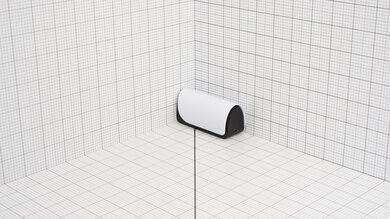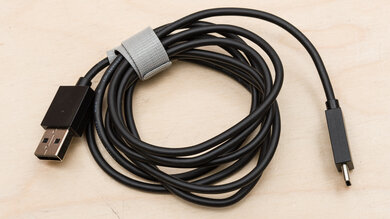The Sony PULSE Explore are wireless earbuds designed for gaming on PlayStation consoles. They have planar magnetic drivers that the manufacturer advertises to improve the clarity and detail of audio. Their transmitter plugs into PlayStation consoles and PCs, providing a wireless connection. They can also connect that way to PlayStation Portal, the company's portable console. However, they also support Bluetooth, so you can connect with your phone or computer to use them more casually. Otherwise, they're somewhat light on features since they don't have a dedicated app, built-in virtual surround sound, or an active noise cancelling (ANC) system.
Our Verdict
The Sony PULSE Explore earbuds are satisfactory for neutral sound. They have planar magnetic drivers, which is unusual for earbuds and can help produce a tighter bass response. Their sound profile offers a bit of bass emphasis with extra rumble that doesn't overpower the mid-range. However, sibilants like cymbals sound a bit dull and sharp, depending on the pitch. You can customize their sound via EQ with the PS5, but they don't have a dedicated app to apply settings when you're connected to another device, like your phone. Their controls are fairly limited, too. On the upside, you can connect to Bluetooth or use the USB dongle.
-
Decent build quality.
-
Very consistent audio delivery.
-
No sound customization features except with PS5 consoles.
-
Continuous battery life is a bit short.
The Sony PULSE Explore earbuds are fair for commuting and traveling. They don't have ANC, so they won't block out rumbling bus and plane engines, and their passive isolation only slightly reduces neighboring traveler's voices. Their roughly five-hour battery life isn't enough for longer journeys, although the case holds two extra charges. They lack a companion app to tweak the sound on the go and remap controls to your taste. However, they have a decently comfortable fit for most people and are also quite portable as Bluetooth earbuds, so if you're looking for gaming headphones that you can also connect with your phone for your commute, they aren't bad.
-
Decent build quality.
-
Good stability.
-
Poor noise isolation.
-
Continuous battery life is a bit short.
The Sony PULSE Explore are very good for sports and fitness, mainly because of their portable in-ear design. However, they're primarily designed for gaming. They lack an IP rating for dust and water resistance, so they aren't the best choice for outdoor runs in rainy or dusty conditions. They have a stable fit but might slip out of place occasionally during intense movements, like during a dance workout. They're also passive-isolating only, so you'll still hear most of the other people and noises in the gym.
-
Decent build quality.
-
Good stability.
-
Support multi-device pairing.
-
Poor noise isolation.
-
No IP rating.
The Sony PULSE Explore earbuds are adequate for office use. They're decently comfortable for most people, so if you get a good fit, they won't cause much fatigue during the day. They support multi-device pairing, so you can use Bluetooth to connect to your smartphone while simultaneously connecting to your PC via a wireless dongle. They only last for about five hours, so you may have to recharge partway through the day. They also lack ANC and won't block out very much noise passively.
-
Decent build quality.
-
Support multi-device pairing.
-
Poor noise isolation.
-
Continuous battery life is a bit short.
The Sony PULSE Explore are okay for wireless gaming. They're designed for PlayStation consoles and have low latency via USB, so your audio and video stay in sync while you play. Their slightly bass-heavy sound profile brings out boomy sound effects, while speech and melodies are reproduced clearly, though the treble range is uneven. You can only customize their sound with an EQ when connected to a PS5 console. They're also quite comfortable for most people. Unfortunately, their mic doesn't have a good recording quality, so your voice sounds distorted when you're chatting with friends.
-
Decent build quality.
-
Low latency with transmitter.
-
Sub-par mic recording quality.
-
Poor noise isolation.
The Sony PULSE Explore are wireless-only earbuds, so you can't use them for wired gaming.
The Sony PULSE Explore earbuds are unremarkable for phone calls. Their integrated mic has a sub-par recording quality, so your voice is understandable but distorted over the phone. The mic struggles to separate your voice from louder noise, and you can be drowned out by something like a truck going by. If you're making a call from a noisy place, you might have difficulty hearing it because they don't block out much noise.
-
Decent build quality.
-
Support multi-device pairing.
-
Sub-par mic recording quality.
-
Poor noise isolation.
- 7.2 Neutral Sound
- 6.8 Commute/Travel
- 7.9 Sports/Fitness
- 6.6 Office
- 6.6 Wireless Gaming
- 5.0 Wired Gaming
- 6.0 Phone Calls
Changelog
-
Updated Jan 21, 2025:
Text for the following test groups have been updated following Test Bench 1.7: Noise Isolation - Full Range and Noise Isolation - Common Scenarios, and ANC Wind Handling. Several Sound tests have also been updated following Test Bench 1.8. There have also been text changes made throughout the review, including to usages to match these results.
- Updated Jan 15, 2025: We've converted this review to Test Bench 1.8, which updates our target curve and Sound tests. You can read more about this in our changelog.
- Updated Jul 24, 2024: We've converted this review to Test Bench 1.7, which updates our Noise Isolation test. We've also expanded the scope of this test to include Common Scenarios in addition to Voice Handling and Wind Handling.
- Updated Jun 27, 2024: The ASUS ROG Cetra True Wireless SpeedNova is mentioned in the Controls and App Support sections for comparison.
- Updated Apr 12, 2024: We've added a comparison between these headphones and the Sony PULSE Elite Wireless in Recording Quality.
Differences Between Sizes And Variants
The Sony PULSE Explore Truly Wireless come in one black and white variant. You can see the label for the unit we tested here. If you encounter another variant, let us know in the comments, and we'll update our review.
Compared To Other Headphones
The Sony PULSE Explore Truly Wireless are earbuds designed for PlayStation 5. Unlike the vast majority of wireless earbuds, they have planar magnetic drivers, which are bulkier but intended to reduce distortion and improve the clarity of audio reproduction. They support Bluetooth as well as PlayStation Link via their USB transmitter, which you can use to connect to PlayStation consoles and PCs. They also connect wirelessly to the PlayStation Portal remote player.
Otherwise, though, they're pretty thin on features. Unlike the Sony INZONE Buds Truly Wireless, they don't support Sony's 360 Reality Audio, which provides a personalized virtual soundstage. They don't have a dedicated app like the Sony INZONE hub with features like a graphic EQ for sound customization. They also block out less noise and have a worse mic performance than other dedicated gaming buds like the INZONE and the EPOS GTW 270 Hybrid Truly Wireless.
If you're looking for recommendations, check out the best earbuds for gaming, the best earbuds and in-ears, and the best gaming headsets.
The Sony PULSE Explore Truly Wireless and the Sony PULSE Elite are both designed for gaming and are equipped with planar magnetic drivers, but the similarities end here. The PULSE Explore are in-ear buds with a more stable and portable design. They deliver audio very consistently across different gaming sessions. By contrast, the PULSE Elite struggle with audio delivery consistency. They have an over-ear design which is too bulky to be portable. On the other hand, they have an excellent microphone, and their continuous battery life is almost ten times that of the PULSE Explore. You can also use them with a wired connection, which gives them greater versatility.
The Sony INZONE Buds Truly Wireless are better for most uses than the Sony PULSE Explore Truly Wireless. The INZONE have a longer battery life, a better mic performance, and a better noise isolation performance, thanks to their ANC feature. They also include a dedicated app with sound customization features. On the other hand, the PULSE support Bluetooth, so you can use their dongle to connect with PlayStation consoles and stream audio from your phone simultaneously.
The Sony PULSE 3D Wireless and the Sony PULSE Explore Truly Wireless are gaming headphones meant for PlayStation consoles; which one you prefer mostly depends on what type of headphones you want. The Explore have a smaller, more portable in-ear design and use planar magnetic drivers, which is intended to improve the clarity of audio. They support Bluetooth, so you can connect them to your phone when you're on the go. On the other hand, the 3D are over-ears with a longer continuous battery life. Their design helps them create a more wide, spacious-seeming passive soundstage. They also have a dedicated app with a graphic EQ and presets for sound customization.
The Razer Hammerhead Pro HyperSpeed True Wireless and the Sony PULSE Explore Truly Wireless are gaming earbuds with different strengths. The Razer have ANC, so they can block ambient sound while you play. Their integrated mic has significantly better performance, and they have an app with sound customization features. However, the Sony have lower latency via non-Bluetooth wireless. They also support Bluetooth, so you can listen to audio from your phone and console simultaneously or use them more casually when you're out and about. They also support PlayStation Link, which allows them to connect wirelessly with the PlayStation Portal remote player for PS5.
The ASUS ROG Cetra True Wireless SpeedNova are more versatile than the Sony PULSE Explore Truly Wireless thanks to their ANC capabilities and longer battery life. Both have low latency when connected via the wireless USB dongle and high latency over Bluetooth. The Sony have a more balanced sound profile compared to the very bassy and piercing ASUS sound, but you can only adjust their settings like EQ and sidetone through the PlayStation 5, whereas the ASUS have mobile and PC app support. On the other hand, the Sony have limited controls, though the dedicated rocker buttons for volume are nice during games, while the ASUS annoyingly require four taps just to change the volume level.
The EPOS GTW 270 Hybrid Truly Wireless are better gaming earbuds than the Sony PULSE Explore Truly Wireless. The EPOS feel sturdier, have a better passive noise isolation performance, and offer a much better mic recording quality. They have a dedicated companion app with sound customization features and support multi-device pairing via Bluetooth or via both Bluetooth and non-Bluetooth wireless. However, you might prefer the Sony PULSE because they have lower latency over non-Bluetooth wireless. The Sony also work with PlayStation Portal, a remote player for the PlayStation that doesn't support Bluetooth or have a USB port.
Test Results
The PlayStation PULSE Explore earbuds have a sleek, curvy aesthetic but are quite big and visible when wearing them. The small black ear tips fit inside your ears, while the white outer faces fit into your outer ear. They're only available in one white and black colorway.
The PlayStation PULSE Explore have a decently comfortable fit for most people. It can take some time to get used to how they fit, and you might need to work at getting a comfortable fit for your ears. The design has sharp edges that can dig into your ear if you don't position them correctly. However, if you twist them into place correctly, they have a snug fit and don't go too far into your ear canal, which avoids a plunger-like feeling.
The Sony Explore earbuds have physical buttons, which is unusual for earbuds. There's a volume rocker on each earbud that controls the earbud volume separately from your device's volume. The upshot of physical buttons is that you can swiftly change the volume while gaming instead of having to tap your bud four times to adjust the volume once, like on the ASUS ROG Cetra True Wireless SpeedNova. Both of the Sony earbuds have the same set of controls. You'll hear audio cues for most commands, and you can hear the physical button presses. However, you don't get any cue when you reach maximum or minimum volume. The buttons also feel mushy and not very clicky.
On both earbuds:
Volume rocker
- Adjust the earbuds' volume.
PS Link button
- Single press: Pair with a Bluetooth or PS Link device.
- Long press: Switch devices.
- Triple press Access EQ settings on PS5.
They're very portable, like most earbuds, and they won't need much space in a bag or pocket, even inside the case. They work with Bluetooth, so you can easily connect with your phone without the USB dongle. However, you need the transmitter to connect them with PlayStation consoles and PCs, so you'll have to remember to bring it with you as well if you plan to game where you're going.
The case is quite a bit bigger than cases for other wireless earbuds like the Apple AirPods Pro Truly Wireless, so it might not slip comfortably into the pocket of your jeans, but it's still very portable and has a curvy black and white design that matches the earbuds. It's light but sturdy, and the sliding lid has a solid, satisfying feel. This mechanism also feels like it might break if you drop the case accidentally, though.
They have a decent build quality. The plastic used is light and feels good quality, but not premium. The buttons on the earbuds are a weak point since they feel mushy and cheap. They aren't rated for water resistance, unlike the Sony INZONE Buds Truly Wireless, which are rated IPX4 for resistance against water splashes.
The PlayStation Explore earbuds have a stable fit. They'll easily stay in place even if you move your head sharply while gaming. While they can fall out sometimes if you make exaggerated movements, it's less likely than with the Sony INZONE Buds Truly Wireless.
- Sony PULSE Explore Truly Wireless
- 4x ear tips (S, M, L, XL)
- Charging case
- USB-A receiver
- USB-A to USB-C charging cable
- Quick Start and User Guide
Note: Our unit is missing one small ear tip and came with an extra large ear tip, but the earbuds are meant to come with four different pairs of differently-sized ear tips.
The PlayStation PULSE Explore use planar magnetic drivers instead of the dynamic drivers found in most earbuds, which is intended to improve the clarity of audio reproduction. Their bass response is smoothly exaggerated across the range, so you hear the rumble, punch, and boom in music and sound effects like footsteps or explosions. Lead instruments and speech are clear and present in the mix due to the mostly balanced mids. The treble is more uneven with a somewhat detailed low-treble response, but exaggerated peaks and valleys can cause sibilant sounds like S and T to sound sharp or dull, depending on the frequency. Lastly, the uppermost frequencies are very de-emphasized, which lends a more closed-off sound without airiness.
They don't have a companion app with sound customization features, although if you're connected to a PS5, you can access an EQ.
They have fantastic frequency response consistency. Once you get a good fit with the ear tips, you'll get the same sound delivery every time you use them.
They have an excellent bass target compliance. It's slightly overemphasized across the range, so your game's soundtrack has thump and rumble. Sound effects like footsteps are also easy to hear.
Their mid-range profile's target compliance is outstanding. Most of the response adheres to our target, so during games with a lot of voice-acted cutscenes, like Baldur's Gate 3, characters' voices sound present and clear in the mix.
Their treble target compliance is disappointing. Most of the low-treble is a bit de-emphasized for a slightly warm tonality that can hurt speech comprehensibility. A boost in the mid-treble can cause S and T sounds to come across as sharp, while a large dip renders upp harmonics dull and lifeless.
Their peaks and dips performance is decent, indicating they control their sound profile well, except for in the upper registers. Most of the bass and mids are tight, with only minor deviations. However, the treble range has a few peaks and dips that can sound a bit harsh and shrill on vocals and cymbals, or dull and lifeless, depending on the pitch. That said, the jagged peaks in the highest frequencies aren't as easily perceived, except for those with sensitive hearing.
They have excellent imaging, like most Sony products we've tested, indicating good quality control and ergonomics. The group delay is below the audibility threshold across the range, resulting in tight bass and transparent treble reproduction. Our unit's left and right drivers are well-matched in phase, amplitude, and frequency response, so objects like instruments and sound effects are accurately placed in the stereo image. However, imaging varies from unit to unit, so your earbuds may perform differently.
They have a bad passive soundstage, which is to be expected from in-ears. Because of their design, their sound doesn't interact with your outer ears, so it seems to come from inside your head rather than speakers in the room around you. The soundstage also seems small and closed-off.
These headphones don't have any virtual surround sound features. You can use Sony's Tempest 3D Audio if you connect to a PlayStation console with the transmitter, but that's the case for any headphones you connect to your PlayStation via USB or by plugging an analog cable into the controller. You can't use this feature if you're connected via Bluetooth.
They have a good weighted harmonic distortion performance. There's some distortion in the low-treble to mid-treble ranges, but it's difficult to hear with real-life content. Otherwise, most of the frequencies result in fairly clean and pure audio reproduction.
These are the settings used to test the PlayStation PULSE Explore. Our results are only valid when the headphones are used with these settings.
They have poor full range noise isolation. They don't have active noise cancelling (ANC) like the Sony INZONE Buds Truly Wireless and don't block out very much noise passively. As a result, they rely on a good in-ear fit and passive isolation to reduce bright and trebly noises, such as squealing brakes on trains. Bassy noises aren't very noticeably blocked, and conversations are only slightly reduced in loudness.
In common scenarios, these have poor noise isolation. Their passive isolation mainly tackles high-pitched noises and slightly reduces the loudness of conversations and traffic. That said, you'll still hear most of your surroundings in an airplane cabin and at the office because they lack ANC.
They have a superb leakage performance. They hardly leak any audio, so you can turn up the volume as much as you like without bothering people around you.
The mic has a sub-par recording quality. Your voice is easy to understand and full-bodied but sounds very distorted. It sounds somewhat better in a more realistic scenario than in an isolated test environment, but you can still hear the distortion. You can listen to that recording here. If you want to prioritize better recording quality, it's worth looking into a headset with a dedicated boom mic, like the Sony PULSE Elite Wireless.
The mic has passable noise handling. It manages to reduce moderately loud background noise, but it'll still be present in the background along with your voice. It can reduce louder noise, like voices or the sound of a train going by, but your voice gets garbled and drowned out simultaneously.
They last for about five hours of continuous use, which isn't very long but matches the manufacturer's advertised battery life. However, they recharge in under an hour, and the case holds two extra charges. You can also use one earbud while the other charges in the case. Keep in mind that battery life varies depending on use, though.
The Sony PULSE Explore earbuds don't have any phone or PC app, unlike the Sony INZONE Buds Truly Wireless, which have a dedicated PC program. However, you can access some settings on PS5, like an EQ, sidetone, and volume. That said, if you want to be able to plug in your wireless dongle to your PlayStation and still have app support when you switch to your phone or Windows PC, consider the ASUS ROG Cetra True Wireless SpeedNova.
The PlayStation PULSE Explore wireless earbuds have high latency via Bluetooth, so you'll notice lip-syncing issues if you're using them to watch videos or are gaming on your phone. However, they aren't intended for gaming via Bluetooth, and you're expected to use the transmitter with your PS5 or PC for a lower latency connection. They support multi-device pairing with Bluetooth and the wireless transmitter, so you can listen to audio from your phone via Bluetooth and hear your game audio at the same time via the transmitter. They also support the AAC codec, which offers slightly improved audio quality compared to the default SBC codec.
They have low latency when connected via their USB dongle to a PlayStation console or PC, so your game's audio and visuals stay in sync while you're playing.
These earbuds are fully compatible with PCs using the wireless transmitter. You can also connect via Bluetooth if your PC supports it.
These earbuds have full audio and mic compatibility with PS4 and PS5 using the wireless transmitter.
The PlayStation PULSE Explore come with a case with a couple of additional charges. It doesn't have any inputs besides the USB-C charging port and doesn't support wireless charging. They also come with a USB dongle that you can plug into PlayStations and PCs to use the headphones wirelessly.
Comments
Sony PULSE Explore Truly Wireless: Main Discussion
Let us know why you want us to review the product here, or encourage others to vote for this product.
Update: Text for the following test groups have been updated following Test Bench 1.7: Noise Isolation - Full Range and Noise Isolation - Common Scenarios, and ANC Wind Handling. Several Sound tests have also been updated following Test Bench 1.8. There have also been text changes made throughout the review, including to usages to match these results.
- 21010
For any standard action driven third person game with loud character voice volume and decent sound effects, what will be the ideal equalizer set up under PS5 sound settings? Can you share any information on that?
Hi there,
Sorry, but at this time, we don’t currently offer custom EQs. It’s also worth nothing each game is mixed differently, so while one EQ may be suitable for a game like CoD, it may not be as good for Baldur’s Gate 3, for example. If you’re looking to lower the volume on character voices or raise sound effects, you could first try adjusting the game’s own internal SFXs; sometimes, they have dedicated sliders that isolate these sounds, so that you have more control over their volume.
The full review has been posted here. Let us know what you think!
- 21010
The volume is too low even by setting all the way to max. However yesterday PS5 released a new update with equalizer setting under sound settings in PS5 and if I turn up all equalizer to +6dB then there is substantial improvement in terms of loudness. Please advise if that is something that is ideal to do so to fix low volume?
This is a good question. Usually, manufacturers will set a limit on the volume of a software EQ to avoid hearing damage. As you noted, the PS5 Equalizer that was released for use with the Pulse Explore is part of a very recent firmware update so it’s possible that they haven’t properly calibrated the maximum volume just yet. However, during testing we didn’t encounter any issues with the volume being too low. We did notice that you could set the volume level on the PS5 independently of the buds themselves, so I just wanted to make sure both are at max volume? If so, adjusting the EQ levels could be a stop-gap solution. I’m not familiar with the exact mechanics of the PS5 EQ but I’m guessing that pulling up all the frequency bands will result in a somewhat unbalanced sound though.




























































































